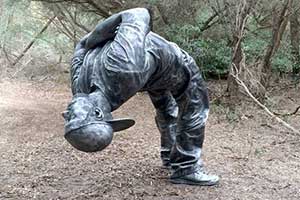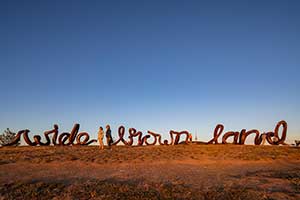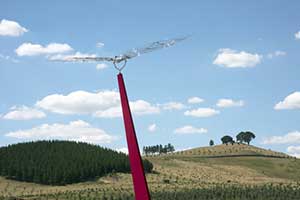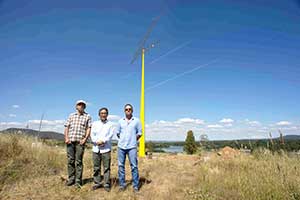The Forest Sculpture Gallery is a world class collection of iconic sculptures set among the trees at the National Arboretum Canberra.
Visit the Forest Sculpture Gallery website
Located within the gardens and forests of the Arboretum, and along its tracks and trails, the Forest Sculpture Gallery is free for public viewing, and showcases works created by some of the world’s most significant artists.
Grab a map and take a leisurely walk, drive or join a sculpture themed walking tour hosted by our friendly volunteer guides.
 A striking metal sculpture of an Australian wedge tail eagle on its nest, Nest III is made from welded steel found-objects, mostly abandoned farm machinery.
A striking metal sculpture of an Australian wedge tail eagle on its nest, Nest III is made from welded steel found-objects, mostly abandoned farm machinery.
The sculpture was created by Richard Moffatt in 2007 and sits at the top of Dairy Farmers Hill.

“A Backwards Attitude” acknowledges a post-digital and enlightenment age where information is everywhere and the correct course of action is clear, but an attitude of rejection thwarts it.
This sculpture represents a pivotal point in technology, its effects on our lives, and our need to recognise that. The work asserts that the entire world is available for digital consumption.
By Louis Pratt, Cold cast aluminium, steel and fibreglass
180cm H x 102cm W x 287cm D. 2 x life size
Location: Forest 21 Mesa oaks Quercus engelmannii (on the western side of Forest Drive)
Louis Pratt’s works are recognised in numerous private and public collections. Most recently, Pratt was the winner of 2016 Tom Bass Figurative Sculpture award 2016 and the 2016 environmental award Sculpture on the Edge. In 2015 Pratt’s sculptures were represented in every major sculpture award in Australia, including the Wynne and Sculpture By The Sea.
 'Wide Brown Land' is 35 metres long and 3 metres high, made from corten steel and steel rod. This iconic sculpture is made by Marcus Tatton, Futago Design Studios and Chris Viney.
'Wide Brown Land' is 35 metres long and 3 metres high, made from corten steel and steel rod. This iconic sculpture is made by Marcus Tatton, Futago Design Studios and Chris Viney.
Based on the three words from the famous poem ‘My Country’ by poet Dorothea Mackellar, in the form and style inspired by Mackellar’s handwriting.
By Marcus Tatton, Futago and Chris Viney, 2010
Corten Steel
My Country
"The love of field and coppice,
Of green and shaded lanes.
Of ordered woods and gardens
Is running in your veins,
Strong love of grey-blue distance
Brown streams and soft dim skies
I know but cannot share it,
My love is otherwise.
I love a sunburnt country,
A land of sweeping plains,
Of ragged mountain ranges,
Of droughts and flooding rains.
I love her far horizons,
I love her jewel-sea,
Her beauty and her terror –
The wide brown land for me!"
Mackellar was born in Sydney's Point Piper in 1885 and died in Sydney in 1968. To learn more about Dorothea Mackellar and her poetry, visit the website.

 Located close to Tuggeranong Parkway, these two Kozo Nishino sculptures are designed to be seen together, reflecting and complementing each other.
Located close to Tuggeranong Parkway, these two Kozo Nishino sculptures are designed to be seen together, reflecting and complementing each other.
Kozo Nishino explains: "I want to create something that evokes air and wind. I would like my sculptures to exist as expressions of the lives we humans live cradled by this atmosphere."
Breezing in Canberra stands seven metres tall and resembles a bird moving in the air. Made of titanium, stainless steel and iron, the sculpture possesses a surprisingly intricate and skeletal steel wire structure, and moves smoothly, reacting to natural movements of the air as if it were a living thing.
Standing 12 metres tall, 'In the Stream' is an abstract design set within the forests near the Tuggeranong Parkway. Made of titanium, stainless steel and iron, 'In the Stream' possesses a surprisingly intricate and skeletal steel wire structure, and moves smoothly, reacting to natural movements of the air as if it were a living thing.
Mr Kozo Nishino, is a leading large-scale artist who has received international acclaim for his public art pieces.
‘Breezing in Canberra’ and ‘In the stream’ were commissioned by artsACT.

This sculptural work by Hannah Quinlivan was commissioned to celebrate the National Arboretums' 10th anniversary since opening to public in 2013 and is anticipated to be installed by late 2024.
Featuring three sculptural elements that will float just above the water's surface on the northern edge of the Ginkgo Dam, the sculptural forms will be arranged in an arc, a nod to the surrounding landscape with the undulations in the sculpture being influenced by the topography of the Arboretum's central valley.
Quinlivan states:
'A few years ago, I found myself digging in the soil by the Murrumbidgee River, just north of Canberra. Dealing with the news of my mother’s terminal cancer, I set about planting two and a half thousand trees. Each sapling served as more than a marker of my grief — they embodied a determination to reconstruct a future amid cycles of life and death. I was shaping the world not just for me, but for my children and grandchildren—turning the soil to find solace and purpose amid loss. Since that time I have become a planter. Each death and each birth is marked by new saplings placed within the earth’s embrace.
Drawing Breath is a sculptural installation that reflects on transformation and reconstruction. It will be situated in the dam at the heart of the National Arboretum in Canberra, a site that itself rose from the devastation of the Canberra bushfires. Just as new life took root in the ashes, this artwork symbolises the beauty that can emerge from devastation, nurturing hope for the future.'
Drawing Breath stands as a reminder that we must do more than remember or reflect — we must work to build a more beautiful future together.
Created from folded and fused aluminium, the topographic folds are in dialogue with the contours of the Arboretum's sloped and terraced landscape. The sculptures undulations suggestive of leaves or petals, maintain a delicate balance between abstraction and organic form. Positioned on the dam’s surface, they create a secondary layer of artwork through their reflection in the water. This mirroring effect invites visitors to contemplate the interconnectedness between humanity and the natural world.
Viewable to pedestrians, and from various vantage points such as the Arboretum’s Village Centre and Dairy Farmers Hill, the sculpture will serve as a landmark along the Tuggeranong Parkway and a feature to welcome visitors to the Arboretum.
Hannah Quinlivan graduated from the Australian National University with a Bachelor of Visual Arts in 2013 and is currently a PhD candidate within the ANU School of Art & Design.
Cloak by artists Jeremy Blincoe & Michael Van Dam, celebrates the essence of the tree as a being in the natural world which is also wholly connected to other living creatures in nature.
Cloak is situated within the mature Himalayan cedar forest of the National Arboretum Canberra. The sculpture stands elegantly, a ghostly form that echoes the repetitious silhouette of the large trunks of the surrounding forest. The form of Cloak is inspired by old-growth hollow trees found throughout Australia, which sustain thriving ecosystems and are teeming with life.
The sculpture has a presence that is simultaneously heavy yet also has a level of transparency. The stainless steel chain inherently provides both positive and negative space through its looped form. This allows light to bounce off the reflective metal, as well as pass through the gaps giving a beautiful shimmering play of light and emulating the silvery colour of old weathered bark. These material properties provide ideas to reflect on such as; strength and fragility, or past and future. The shiny surface monumentalises and makes new an object that has stood the test of time, a strong and durable façade that still allows light, air and life to continue in it's presence.
In 2020 Jeremy Blincoe graduated from a Masters of Contemporary Art at the VCA, Melbourne. Since 2006 he has held fifteen solo exhibitions including Korea, Switzerland, and New Zealand. He has won prestigious prizes including the Fiona Myer Award at VCA (2020), Brisbane Art Prize (2017), Fisher Ghost Arts Prize (2017), Kaipara Wallace Arts Trust Award (2016), and has work in the collection of Gippsland Art Gallery & Pah homestead.
Dutch/Australian Artist and Stainless steel expert Mike (Michael) Van Dam, born in New Zealand and living in Queensland - Gold Coast Australia and father of two children, creates sculptures made from stainless steel chain.
Stainless steel chain
320.0 (h) x 250.0 (w) x 80.0 (d) cm
Location: Forest 11 Himalayan Cedar Cedrus deodara

This 2016 work A literary map of the Molonglo by Ian Marr charts two vital aspects of the Canberra region: the Molonglo River, at the heart of the city of Canberra where it was dammed to form Lake Burley Griffin, and the writers and artists who made their lives here and created the intellectual and cultural landscape of the city and surrounds.
Writers’ names include poets Geoff Page, David Campbell, Rosemary Dobson, A D Hope and Les Murray (who lived in Downer as a young man). Artists’ names include (Elioth) Gruner, (William) Lister Lister and (Rosalie) Gascoigne, all known for their representations of the Canberra landscape. Other names include Café Neruda (well known for poetry readings) and Brindabella Press, a private press that published poetry and literary fiction, particularly that from the region.
Mintaro slate slab
30.0 (h) x 380.0 (w) x 55.00 (d) cm
Location: Grassy hill beside Forest 41 Pin oak Quercus palustris ‘Freefall’, overlooking the Gallery of Gardens and Events Terrace

